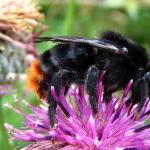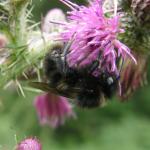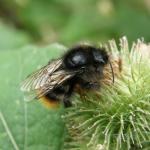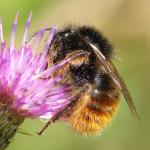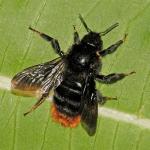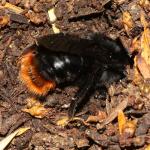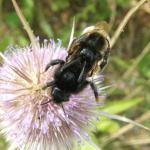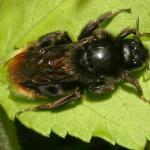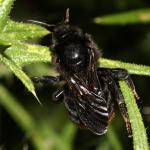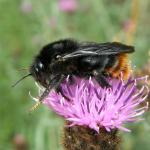Apis arenaria PANZER 1801; Apis frutetorum PANZER 1801; Apis albinella KIRBY 1802; Psithyrus frutetorum var. interruptus LEPELETIER 1832; Bombus obscurus SEIDL 1838
Follows P. Williams: http://www.nhm.ac.uk/research-curation/research/projects/bombus/ps.html#rupestrisUntil recently this species was known as Psithyrus rupestris but Psithyrus has now been reduced to a subgenus within Bombus. This is a large cuckoo-bee which is a social parasite on the common and widespread red-tailed bumble bee, Bombus lapidarius. Both species are all black with a red tail, but the female parasite has darker wings. Identification keys and general biology are found in Sladen (1912), Free & Butler (1959), Alford (1975) and Prŷs-Jones & Corbet (1991).
Widespread throughout the British Isles, particularly in southern England, this species declined considerably during and after the 1940s but has shown a remarkable resurgence in the past decade. The host is very widespread and appears to be currently increasing its range northward.
The species ranges from southern Fennoscandia south to the northern coast of the Mediterranean and Sicily, and eastwards to Siberia, Mongolia and northern Kazakhstan (Loken, 1984).
Listed as a Notable (B) species Falk (1991) [now known as Scarce (Nb)], but becoming more abundant.
Although its host is a frequent species in gardens, most records relate to areas of unimproved grasslands
The females do not usually come out of hibernation until late May or June and can be seen searching for host nests during the latter month. The new generation of adults emerges in late July or August
In early summer, each female Bombus rupestris enters an established nest of B. lapidarius where it attacks and kills the resident queen. The parasite then establishes itself as the "queen" in the nest with its complement of B. lapidarius workers. The female B. rupestris lays female, and then male eggs that will be reared by the B. lapidarius workers. Once egg laying is completed, the female B. rupestris dies in the nest.
Mainly plants in the families Apiaceae, Lamiaceae and Asteraceae.
None specifically recorded in Britain
Profile written: 2001
Proofed: February 2012


